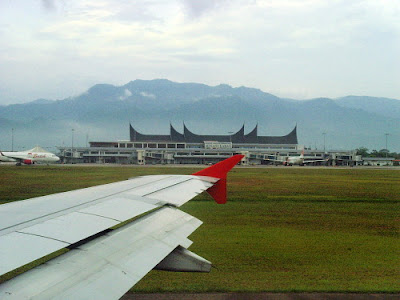We revisited the Tapan road arriving to thick fog. We decided to walk down the road from the ranger station located at the ridge-top. The fog soon started to clear and we were soon watching our first Sumatran Green Pigeons. A little further and our first Sumatran Spangled Drongo was encountered. Dwi explained that only 5 years ago both Blue-masked and Sumatran Leafbirds were both commonly seen species along the Tapan road, but that very sadly, since then they have both been heavily trapped at this site - we were to see neither - it seemed hard to believe that in what appeared a large area of forest two arboreal species could be so effectively removed from the avifauna. We were more fortunate with a third species that is also being targeted by the trappers, as an Orange-spotted Bulbul was encountered, albeit just the one. A small flock of Swiflets were tentatively identified as Edible-nest Swiftlets using the criteria detailed in Eaton et al. (2016). We then heard a Sumatran Peacock-Pheasant calling from the forest. Playback resulted in the bird approaching to probably roughly halve the original distance from us to the bird. There was a small area of forest floor visible in that vicinity so I focussed there but it was never seen to cross. Much to our frustration, probably the three largest and heaviest trucks of the morning then chose that moment to drive past us. The Peacock-Pheasant fell silent and we never heard it again. Having walked to yesterday's Pitta stakeout I was keen to be the first to walk into the gully just in case my most-wanted species for the morning was present - much to my surprise it was - the only species of Forktail that I hadn't previously seen, albeit if the IOC adopts the Birds of the Indonesian Archipelago's proposal to split Javan, there might yet be another to look for... As I was the only one to see the Forktail before it flew upstream we waited awhile and it eventually reappeared. There was no sign of the Graceful Pittas today - presumably our early morning visit the previous day had been essential. We continued to walk most of the way to the bridge where very heavy rain again commenced around 3pm so we again called it a day.
SUMATRAN PEACOCK-PHEASANT h
Little Cuckoo Dove 10
Barred Cuckoo Dove 2
SUMATRAN GREEN PIGEON 12
Wedge-tailed Green Pigeon 2
Green-billed Malkoha 2
BOCK'S HAWK-CUCKOO h
Square-tailed Drongo-Cuckoo h
EDIBLE-NEST SWIFTLET 20
Changeable Hawk-Eagle 1 juvenile
Blyth's Hawk-Eagle 2
Rufous-bellied Eagle 2
Sumatran Trogon 1
Wreathed Hornbill 4
Fire-tufted Barbet 6
Black-browed Barbet 8
Long-tailed Broadbill 2
Black-and-crimson Oriole 2
Grey-chinned Minivet 1
Ashy Drongo 10
SUMATRAN SPANGLED DRONGO 3
Sumatran Treepie 5
Pacific Swallow 2
ORANGE-SPOTTED BULBUL 1
Cream-striped Bulbul 8
Spot-necked Bulbul 6
Grey-throated Babbler 2
SUNDA SANGKAR WHITE-EYE 1
Hill Prinia 2
SUNDA FORKTAIL 1
Mugimaki Flycatcher 1
Tree Sparrow 4
Grey Wagtail 1
Tapan road, Kerinci
Male Barred Cuckoo Dove along the Tapan road, Kerinci
Sumatran Green Pigeon along the Tapan road, Kerinci
Wedge-tailed Green Pigeon along the Tapan road, Kerinci
Sunda Sangkar White-eye along the Tapan road, Kerinci
Whilst Eaton et al (2016), xeno-canto and ebird treat buxtoni as a form of Sunda White-eye the IOC appear to consider it a form of Hume's White-eye pending further investigation.

Juvenile Changeable Hawk-Eagle
Rufous-bellied Eagle along the Tapan road, Kerinci
Blyth's Hawk-Eagle along the Tapan road, Kerinci
Male Wreathed Hornbill along the Tapan road, Kerinci
Female Wreathed Hornbill along the Tapan road, Kerinci
Juvenile Wreathed Hornbill along the Tapan road, Kerinci
Orange-spotted Bulbul along the Tapan road, Kerinci
Edible-nest Swiftlet along the Tapan road, Kerinci
note the combination of the slightly paler rump and notable tail notch
Black-browed Barbet along the Tapan road, Kerinci
Ashy Drongo along the Tapan road, Kerinci
Our favourite ravine produces two days running ...
Sunda Forktail along the Tapan road, Kerinci
Dwi and his son with our trustworthy vehicle in the background
Pak Subandi's homestay (blue) being our base for six nights
Keresik Tua and its mosque
seeing visiting foreigners still seemed something of a novelty
Kerinci awaiting to be climbed again in the morning ...





















































































